Financial Accounting and its Purposes
22 Pages3990 Words32 Views
Added on 2023-01-06
About This Document
This document provides an overview of financial accounting and its purposes. It explains the stakeholders of a large organization and provides insights into the journal entries and ledger accounts for a sole trader. The document also covers topics such as financial statements, double-entry bookkeeping, and underlying principles of financial accounting.
Financial Accounting and its Purposes
Added on 2023-01-06
ShareRelated Documents
Financial Accounting
1
1
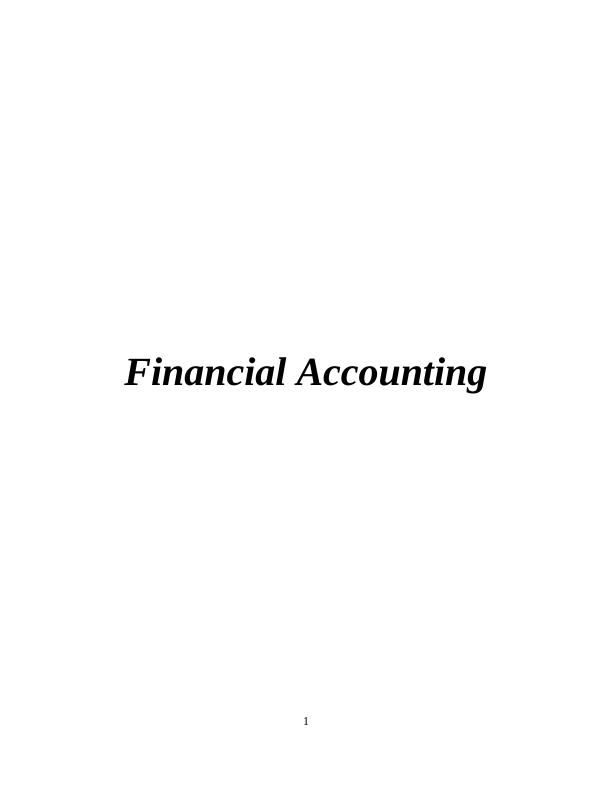
Table of Contents
Introduction......................................................................................................................................3
Part A...............................................................................................................................................3
Financial Accounting and its purposes...................................................................................3
Stakeholders of a large organisation.......................................................................................6
Part B...............................................................................................................................................7
Client 1...................................................................................................................................7
Client 2.................................................................................................................................16
Client 3.................................................................................................................................17
Client 4.................................................................................................................................18
Client 5.................................................................................................................................19
Conclusion.....................................................................................................................................20
References......................................................................................................................................21
2
Introduction......................................................................................................................................3
Part A...............................................................................................................................................3
Financial Accounting and its purposes...................................................................................3
Stakeholders of a large organisation.......................................................................................6
Part B...............................................................................................................................................7
Client 1...................................................................................................................................7
Client 2.................................................................................................................................16
Client 3.................................................................................................................................17
Client 4.................................................................................................................................18
Client 5.................................................................................................................................19
Conclusion.....................................................................................................................................20
References......................................................................................................................................21
2
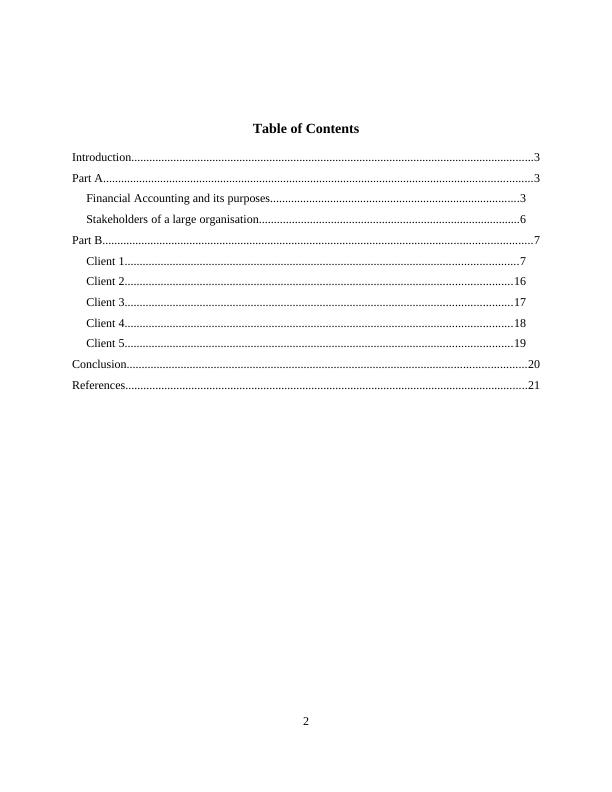
Introduction
Financial accounting is related to the preparation and presentation of financial
information of a company's business performance. Purpose of financial accounting is financial
reporting (Birkenmaier Oliver and Huang, 2020). These reports reflects position and
performance of business to all its stakeholders. Stakeholders are parties that are interested in
affairs of the business. They can be internal or external for an organisation. They decide on their
course with company based on the financial reports. These reports include final accounts such as
income statement, balance sheet, cash flow statement, etc. Final accounts are drawn out of
recording financial transactions in books of accounts such as journal, ledgers, special subsidiary
books of accounts, trial balance, etc.
Part A
Financial Accounting and its purposes
Financial Accounting
Financial accounting is a branch of accounting that is concerned with recording,
summarising, analysing and presentation of financial transactions of a business. Transactions are
presented in financial statements such as income statement, Balance Sheet and cash flow
statement. All organisation have two kinds of stakeholders – internal and external. Internal
stakeholder includes owners, investors and employees of organisation while external
stakeholders include creditors, customers, government, etc. Financial accounting aims at
providing information to both external and internal stakeholder while management accounting is
concerned with only internal stakeholders (Flower and Ebbers, 2018).
Basis for comparison Financial Accounting Management Accounting
User It is used by both internal and
external stakeholders for
making their informed
business decision.
It is only for the use by internal
management of the
organisation to make relevant
business decisions
Contents It includes only those
transactions which are
financial in nature.
It is concerned with both
financial and non financial
information.
3
Financial accounting is related to the preparation and presentation of financial
information of a company's business performance. Purpose of financial accounting is financial
reporting (Birkenmaier Oliver and Huang, 2020). These reports reflects position and
performance of business to all its stakeholders. Stakeholders are parties that are interested in
affairs of the business. They can be internal or external for an organisation. They decide on their
course with company based on the financial reports. These reports include final accounts such as
income statement, balance sheet, cash flow statement, etc. Final accounts are drawn out of
recording financial transactions in books of accounts such as journal, ledgers, special subsidiary
books of accounts, trial balance, etc.
Part A
Financial Accounting and its purposes
Financial Accounting
Financial accounting is a branch of accounting that is concerned with recording,
summarising, analysing and presentation of financial transactions of a business. Transactions are
presented in financial statements such as income statement, Balance Sheet and cash flow
statement. All organisation have two kinds of stakeholders – internal and external. Internal
stakeholder includes owners, investors and employees of organisation while external
stakeholders include creditors, customers, government, etc. Financial accounting aims at
providing information to both external and internal stakeholder while management accounting is
concerned with only internal stakeholders (Flower and Ebbers, 2018).
Basis for comparison Financial Accounting Management Accounting
User It is used by both internal and
external stakeholders for
making their informed
business decision.
It is only for the use by internal
management of the
organisation to make relevant
business decisions
Contents It includes only those
transactions which are
financial in nature.
It is concerned with both
financial and non financial
information.
3
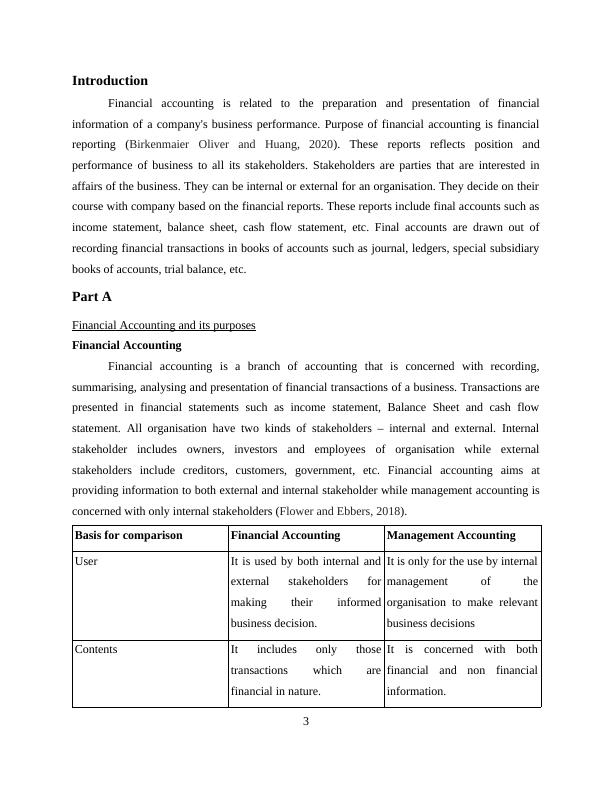
Regulation It is subjected to multiple laws,
rules and regulations by
different authorities and are
prepared accordingly.
It it out of all legal purviews
and is prepared according to
management directions.
Purpose of financial accounting
Purpose of financial accounting is to prepare and present proper general purpose financial
statements (Foster, 2015). It helps management knowing whether company is incurring
profits or losses, what are the major sources of expenses, position of assets, investments
and liabilities, etc. Managerial accounting then takes over. Management analyses the
information extracted.
Financial statements provide necessary information to all stakeholders. This information
aids stakeholders in making their decisions regarding their association with company. For
example - it helps shareholders in deciding whether they should continue with their
investment in the company or withdraw it. Financial statements help management in
taking decisions regarding business operations and financial well being of the company.
Financial statements have quantified data. These statements serve as a base for
comparison between different products, departments, organisations and markets in
quantitative terms.
In order to maintain uniformity in all accounts of all business organisations, financial
accounting is performed according to some general standards, rules and guidelines. International
Financial Reporting Standards (IFRS) and Generally Accepted Accounting Principles (GAAP)
have been prescribed that has to be followed by organisations all over.
Financial accounts are prepared on double entry book keeping system. It says that each
transaction affects at least two accounts and thus, for every debit in an account, there is
simultaneous and equal credit in some another account (Galariotis, Rong and Spyrou, 2015).
There are two different ways of recording financial transactions – Cash and accrual basis. Under
cash basis, incomes and expenses are only recorded as and when cash is received or paid
respectively. Under accrual basis, revenue and expenses are recognised as and when they
become due, irrespective of cash treatment being met or not.
4
rules and regulations by
different authorities and are
prepared accordingly.
It it out of all legal purviews
and is prepared according to
management directions.
Purpose of financial accounting
Purpose of financial accounting is to prepare and present proper general purpose financial
statements (Foster, 2015). It helps management knowing whether company is incurring
profits or losses, what are the major sources of expenses, position of assets, investments
and liabilities, etc. Managerial accounting then takes over. Management analyses the
information extracted.
Financial statements provide necessary information to all stakeholders. This information
aids stakeholders in making their decisions regarding their association with company. For
example - it helps shareholders in deciding whether they should continue with their
investment in the company or withdraw it. Financial statements help management in
taking decisions regarding business operations and financial well being of the company.
Financial statements have quantified data. These statements serve as a base for
comparison between different products, departments, organisations and markets in
quantitative terms.
In order to maintain uniformity in all accounts of all business organisations, financial
accounting is performed according to some general standards, rules and guidelines. International
Financial Reporting Standards (IFRS) and Generally Accepted Accounting Principles (GAAP)
have been prescribed that has to be followed by organisations all over.
Financial accounts are prepared on double entry book keeping system. It says that each
transaction affects at least two accounts and thus, for every debit in an account, there is
simultaneous and equal credit in some another account (Galariotis, Rong and Spyrou, 2015).
There are two different ways of recording financial transactions – Cash and accrual basis. Under
cash basis, incomes and expenses are only recorded as and when cash is received or paid
respectively. Under accrual basis, revenue and expenses are recognised as and when they
become due, irrespective of cash treatment being met or not.
4
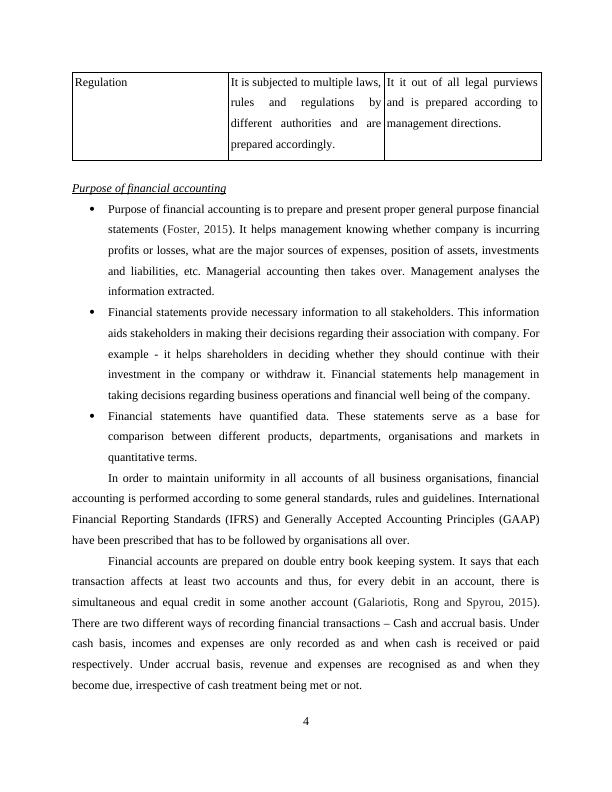
Financial accounts follows some underlying principles, assumptions and conventions.
Principles such as historical cost concept, matching principle, revenue recognition principle, full
disclosure principle, etc. are to be followed. Businesses are expected to follow assumptions such
as going concern assumption, separate entity assumption, fixed time period assumption, money
measurement assumption, etc. (Kemp and Morgan, 2019) Some conventions such as conventions
of materiality, cost benefit, conservatism, etc. are also followed. Necessary financial statements
that are required to be prepared on the above basis are as follows:
Income Statement – It is also known as profit and loss statement. It is a period statement
as it is prepared for a specified period of time. In it, all revenues, gains, expenses and losses of
business are recorded and then profit or loss is determined at the period end. Surplus of revenue
over expenses are called profit. Companies are required to used accrual basis of accounting to
record financial transactions. Accordingly, revenues and expenses are recorded as and when they
occur, regardless of when payment occurs.
Balance Sheet - It is a position statement as it shows the position of business assets and
liabilities at a specified point of time. Balance Sheet is prepared on the basis of fundamental
equation:
Assets = Liabilities + Shareholders' Equity.
Balance Sheet is divided in two sides – one is called assets side and other is called
liabilities side. Assets side shows all current and non-current assets and investments. Liabilities
side show shareholders' equity information as well as information about current and non-current
liabilities.
Cash Flow Statement – It is a financial statement that records all inflows and outflows
of cash and cash equivalents of a company in a specific period of time. It is divided into three
parts – cash flow from operating activities, investing activities and financing activities. Cash
flow from operations includes inflow and outflow from all operational business activities. Cash
flow from investment records gains and losses out of business investments (Reinsdorf and et.al.,
2017). Final section of cash flow from financing activities provides an account of cash usage in
and out because of debt and equity. Sum of all three segments is called net cash flow from
business activities. It acts like a bridge between income statement and balance sheet of business.
These three above statements help management and investors' determine the financial
performance and position of company as a whole.
5
Principles such as historical cost concept, matching principle, revenue recognition principle, full
disclosure principle, etc. are to be followed. Businesses are expected to follow assumptions such
as going concern assumption, separate entity assumption, fixed time period assumption, money
measurement assumption, etc. (Kemp and Morgan, 2019) Some conventions such as conventions
of materiality, cost benefit, conservatism, etc. are also followed. Necessary financial statements
that are required to be prepared on the above basis are as follows:
Income Statement – It is also known as profit and loss statement. It is a period statement
as it is prepared for a specified period of time. In it, all revenues, gains, expenses and losses of
business are recorded and then profit or loss is determined at the period end. Surplus of revenue
over expenses are called profit. Companies are required to used accrual basis of accounting to
record financial transactions. Accordingly, revenues and expenses are recorded as and when they
occur, regardless of when payment occurs.
Balance Sheet - It is a position statement as it shows the position of business assets and
liabilities at a specified point of time. Balance Sheet is prepared on the basis of fundamental
equation:
Assets = Liabilities + Shareholders' Equity.
Balance Sheet is divided in two sides – one is called assets side and other is called
liabilities side. Assets side shows all current and non-current assets and investments. Liabilities
side show shareholders' equity information as well as information about current and non-current
liabilities.
Cash Flow Statement – It is a financial statement that records all inflows and outflows
of cash and cash equivalents of a company in a specific period of time. It is divided into three
parts – cash flow from operating activities, investing activities and financing activities. Cash
flow from operations includes inflow and outflow from all operational business activities. Cash
flow from investment records gains and losses out of business investments (Reinsdorf and et.al.,
2017). Final section of cash flow from financing activities provides an account of cash usage in
and out because of debt and equity. Sum of all three segments is called net cash flow from
business activities. It acts like a bridge between income statement and balance sheet of business.
These three above statements help management and investors' determine the financial
performance and position of company as a whole.
5
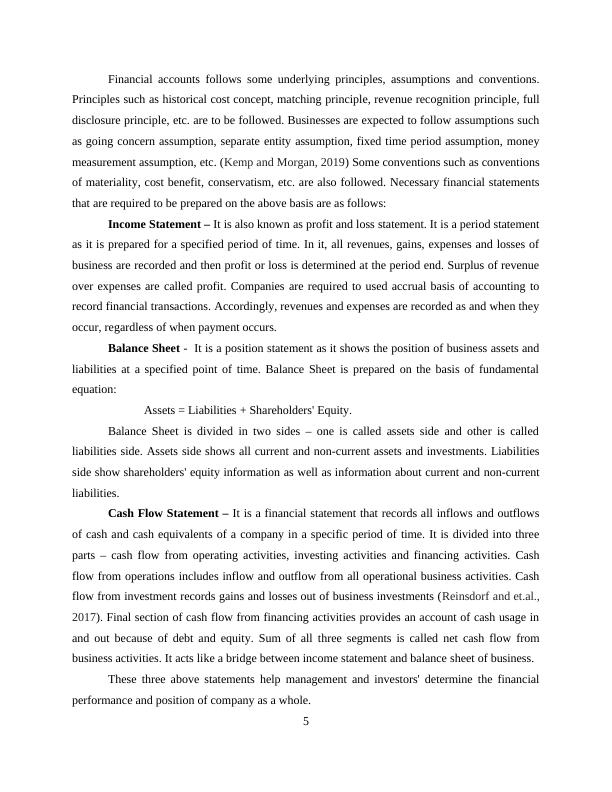
Stakeholders of a large organisation
Stakeholder refers to any party that has a legitimate interest in the business of an
organisation. Some stakeholders have direct effect over organisation while some yield indirect
effect. Stakeholders are of two types – internal and external stakeholders.
Internal stakeholders- These are primary stakeholders which are directly involved in the
operations of a business (Shapiro and Hanouna, 2019). They get direct rewards on the success of
business. They primarily consists of employees, owners and managers of the organisation who
are directly involved in the operations of the business. Company's financial health and success is
directly co-related to primary stakeholders own personal benefits. Few internal stakeholder are
discussed below: Employees- Employees invest their time, energy and skills to run to operations of the
organisation. They also have financial stake in the company. Thus, it is important for
management to take into account employees opinions and expectations while forming
company's values, vision and mission statement.
Owners – Owners are shareholders of the organisation. All shareholders are stakeholder
of an organisation but not all stakeholders are shareholders. They have direct financial
stake in the organisation and thus are considered about every strategy and decision taken
for the organisation.
External stakeholders
These are varied sections of society that get impacted by the operations of organisation.
They need not have direct financial stake in the company but impacts business operations
indirectly (Tonkin and et.al., 2020). For example customers, creditors, government, suppliers,
etc. Management understands their responsibilities towards external stakeholders and keep in
mind to disclose necessary information relating to them when preparing and presenting financial
accounts. Few external stakeholders are discussed below: Customers – Customers are most important stakeholders of a business. They are
concerned with the price, quality and value of the product or service being provided to
them. Suppliers – Suppliers are the stakeholders that provide necessary supplies to the
organisation. Company is their customer and it relies on company for their revenue and
6
Stakeholder refers to any party that has a legitimate interest in the business of an
organisation. Some stakeholders have direct effect over organisation while some yield indirect
effect. Stakeholders are of two types – internal and external stakeholders.
Internal stakeholders- These are primary stakeholders which are directly involved in the
operations of a business (Shapiro and Hanouna, 2019). They get direct rewards on the success of
business. They primarily consists of employees, owners and managers of the organisation who
are directly involved in the operations of the business. Company's financial health and success is
directly co-related to primary stakeholders own personal benefits. Few internal stakeholder are
discussed below: Employees- Employees invest their time, energy and skills to run to operations of the
organisation. They also have financial stake in the company. Thus, it is important for
management to take into account employees opinions and expectations while forming
company's values, vision and mission statement.
Owners – Owners are shareholders of the organisation. All shareholders are stakeholder
of an organisation but not all stakeholders are shareholders. They have direct financial
stake in the organisation and thus are considered about every strategy and decision taken
for the organisation.
External stakeholders
These are varied sections of society that get impacted by the operations of organisation.
They need not have direct financial stake in the company but impacts business operations
indirectly (Tonkin and et.al., 2020). For example customers, creditors, government, suppliers,
etc. Management understands their responsibilities towards external stakeholders and keep in
mind to disclose necessary information relating to them when preparing and presenting financial
accounts. Few external stakeholders are discussed below: Customers – Customers are most important stakeholders of a business. They are
concerned with the price, quality and value of the product or service being provided to
them. Suppliers – Suppliers are the stakeholders that provide necessary supplies to the
organisation. Company is their customer and it relies on company for their revenue and
6
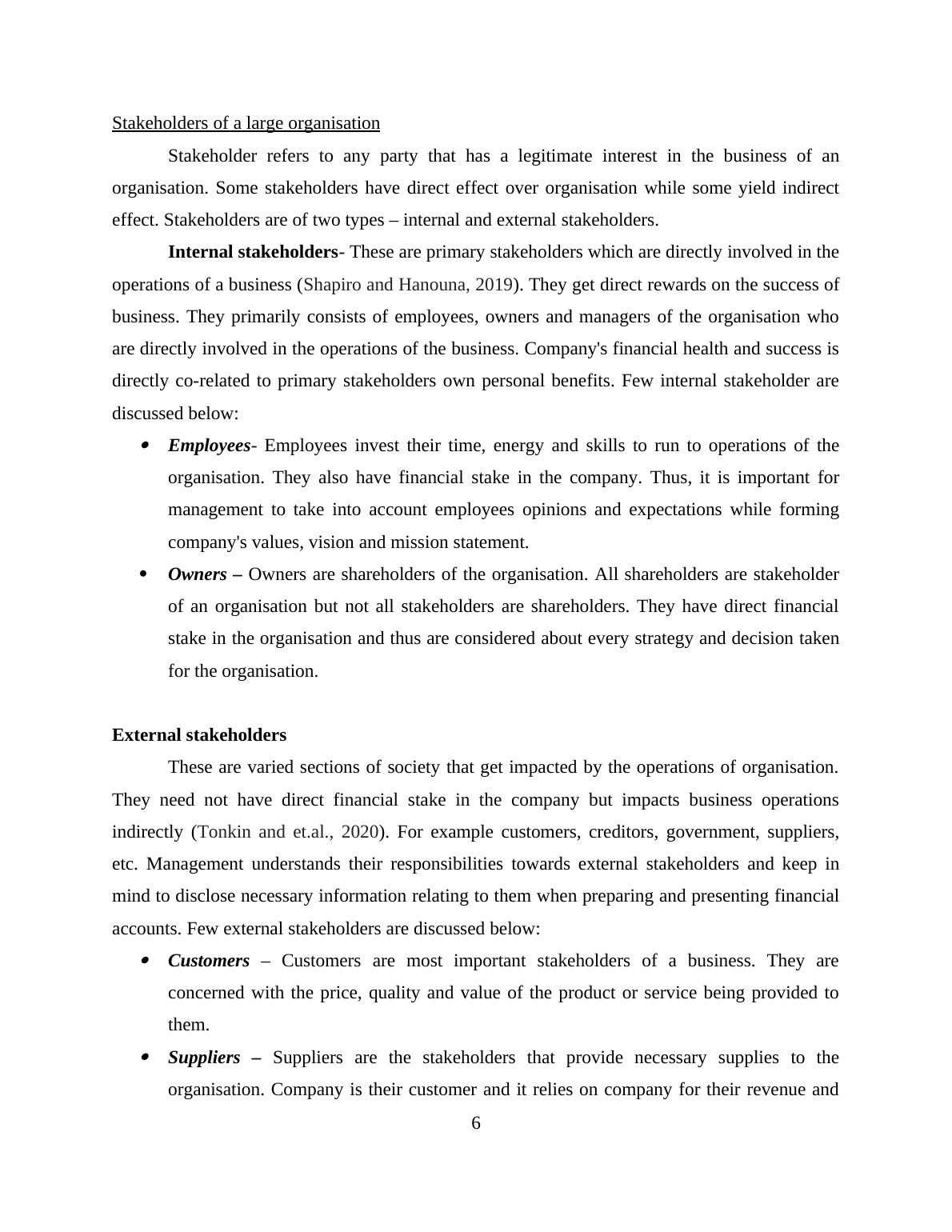
End of preview
Want to access all the pages? Upload your documents or become a member.
Related Documents
Financial Accounting Principles Assignment Solutionlg...
|25
|4151
|240
Solved Financial Accounting : Assignmentlg...
|30
|4790
|26
Financial Accounting Principles Assignment - Airdri companylg...
|30
|6507
|439
Introduction to Financial Accounting (pdf)lg...
|25
|4847
|60
Purpose of Accounting Assignmentlg...
|18
|3334
|164
FINANCIAL ACCOUNTING PINCIPLES TABLE OF CONTENTS INTRODUCTION 4 1. Financial Accounting Principles of Munteanu Ltdlg...
|26
|5321
|460
